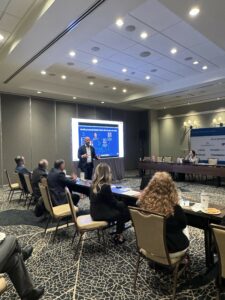Abstract
Health plan executives gathered in Austin this Spring with a common frustration: despite functioning analytics teams and mountains of data, delivering the right care to the right member at the right time still remains largely an elusive goal. At the Millennium Alliance event, the Siftwell team didn’t just talk about this challenge—they demonstrated how it can be solved live, inspiring discussion on how their approach cuts through the noise to deliver what plan leaders actually need.
“We’re not just using AI to predict cost. We’re using causal frameworks to identify what actions will actually change outcomes.”
The interactive session revealed key concerns that resonated across the payers and providers in the room:
- “Plans have been doing analytics off claims data for ages. How is it you could find more?”
“Just claims + eligibility + our external data equals more opportunity than you can act on. We don’t need EMRs or labs,” Trey Sutten, CEO & Co-Founder of Siftwell and former CFO of North Carolina Medicaid, explained. Our team demonstrated how we combine your eligibility and claims data with 15,000+ external data elements to create a rich picture of member needs that traditional risk stratification tools simply can’t match. Especially for complex populations like Medicaid, this approach allows us to identify impactable cohorts even without extensive clinical data.
- “What about our old campaign spreadsheets?”
“Upload them. We ingest and simulate which of your past efforts would work for today’s population,” Eben Esterhuizen, CTO & Co-Founder of Siftwell, shared. We don’t discard your historical knowledge—we enhance it. By analyzing which past campaigns worked for specific segments, we can simulate how those same approaches might perform with your current population and recommend refinements for even greater impact.
- “We don’t have complete data, and that includes SDOH data.”
“We use sophisticated proxies and don’t require you to have formally collected SDOH data,” Eben clarified. “Our system incorporates food sources, health education sources, sentiments, and even radio station preferences to infer behavioral drivers. For example, we can determine transportation challenges without direct member reporting by analyzing distance to providers, public transit routes, and car ownership data. This approach allows us to identify social determinants at scale without burdening your team with new data collection processes.”
- “Does this consider member behavior? It’s one thing to know who to target, it’s another to engage them.”
“Yes. Siftwel’s dataset includes 200+ datasets on behaviors like ad response, trust in hospitals, PCP vs. ED preference. We curated them and layered them in.” the team explained. Our behavioral modeling approach incorporates extensive psychographic data that reveals crucial insights about how members make healthcare decisions. We understand not just what care they need, but how they prefer to receive information and which messages will resonate with them.
- “How do you handle outreach in challenging areas like rural Georgia?”
One attendee noted, “I’m in Georgia. Once you get outside the perimeter, folks don’t trust the big-city doctors… It has to come from clergy, community, barbershops.” Our team responded: “Totally agree. One client in the Mountain West ran a rodeo ad to reach rural members. It’s all about being relevant.” This example demonstrates how our approach considers cultural context and communication preferences, not just clinical needs.
Beyond Risk Stratification: Actionable Intelligence
 Trey demonstrated how Siftwell addresses the limitations of conventional approaches:
Trey demonstrated how Siftwell addresses the limitations of conventional approaches:
“We’re not just surfacing risk—we’re surfacing next best actions that you can take, mapped to outcomes that matter.”
The live demonstration showed how by combining plan data with Siftwell data – currently over 15,000 external data elements that are highly localized to your region- our platform creates impactable cohorts with tailored, actionable intervention recommendations. It’s not just another overwhelming rank-ordered list of high-risk members; we take member lists from 10,000s to 100 of your most impactable and shape them for your frontline teams to be able to take decisive action.
One example revealed a cluster of approximately 90 predominantly female members, ages 60–65, currently costing $2,600 PMPY but projected to increase to $20,000. The system identified their specific barriers, including low technology adoption and computer access—examples of insights that enable precisely targeted campaigns.
While we can query complex questions in minutes, what truly sets Siftwell apart is how we transform results into implementable strategies:
“Whether your team needs a board-ready deck or a frontline-ready list, we meet you where you are and guide action from day one.”
Renee Malone, Head of Customer Success, emphasized this advantage:
“Data is only as good as what you can use. What’s powerful here is the ability to identify where to focus first. With limited resources, knowing where to target your team and vendors is critical.”
Proven Results, Not Just Predictions
- A targeted effort to increase member engagement and renewal led to a 14% increase in retention, a 15% increase in preventive service use, and statistically significant increases in quality measure-associated health behaviors.
- A targeted campaign for 12,000 women unlikely to get cancer screenings—segmented into 450 with identical barriers—was part of a strategy that achieved record-high screening rates
A Partnership Approach
The Siftwell platform delivers:
- Population-level analysis that considers claims and eligibility data, but also environmental, social, and behavioral factors
- Risk stratification that illuminates Impactable Member Cohorts
- Modeled Next Best Actions to help you evaluate what actions can create the most impact, for whom
- Projected ROI of each Next Best Action Campaign to help you plan concerted action
- Ongoing analysis of performance
- The Siftwell team of healthcare operators sitting alongside you to adapt to your evolving needs
But technology alone isn’t enough. As the team emphasized in closing:
“This is not a ‘shiny tool.’ It’s an ongoing, cross-functional partnership to realize outcomes.”
The demonstration emphasized that with the right combination of data science, behavioral insights, and implementation support, healthcare organizations can transform how they identify, engage, and support their most complex populations. Afterall, the origin of Siftwell began because our team has been in your shoes. As former MCO operators, we have created the tools we wish we had as plan leaders—one that actually tells you who needs what, and how to reach them effectively
→ See how it can work for you.



